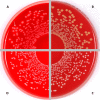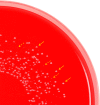Coagulase-negative staphylococci
- PMID: 25278577
- PMCID: PMC4187637
- DOI: 10.1128/CMR.00109-13
Coagulase-negative staphylococci
Abstract
The definition of the heterogeneous group of coagulase-negative staphylococci (CoNS) is still based on diagnostic procedures that fulfill the clinical need to differentiate between Staphylococcus aureus and those staphylococci classified historically as being less or nonpathogenic. Due to patient- and procedure-related changes, CoNS now represent one of the major nosocomial pathogens, with S. epidermidis and S. haemolyticus being the most significant species. They account substantially for foreign body-related infections and infections in preterm newborns. While S. saprophyticus has been associated with acute urethritis, S. lugdunensis has a unique status, in some aspects resembling S. aureus in causing infectious endocarditis. In addition to CoNS found as food-associated saprophytes, many other CoNS species colonize the skin and mucous membranes of humans and animals and are less frequently involved in clinically manifested infections. This blurred gradation in terms of pathogenicity is reflected by species- and strain-specific virulence factors and the development of different host-defending strategies. Clearly, CoNS possess fewer virulence properties than S. aureus, with a respectively different disease spectrum. In this regard, host susceptibility is much more important. Therapeutically, CoNS are challenging due to the large proportion of methicillin-resistant strains and increasing numbers of isolates with less susceptibility to glycopeptides.
Copyright © 2014, American Society for Microbiology. All Rights Reserved.
Figures










References
-
- Billroth T. 1874. Untersuchungen über die Vegetationsformen von Coccobacteria septica und den Antheil, welchen sie an der Entstehung und Verbreitung der accidentellen Wundkrankheiten haben: Versuch einer wissenschaftlichen Kritik der verschiedenen Methoden antiseptischer Wundbehandlung. G Reimer, Berlin, Germany
Publication types
MeSH terms
Substances
LinkOut - more resources
Full Text Sources
Other Literature Sources
Medical
Molecular Biology Databases

